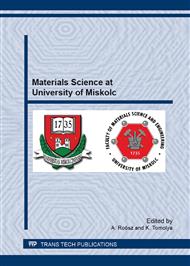[1]
R.N. Jagtap, R. Nambiar, S.Z. Hassan, V.C. Malshe, Predictive power for life and residual life of the zinc rich primer coatings with electrical measurement, Prog. Org. Coat. 58 (2007) 253–258.
DOI: 10.1016/j.porgcoat.2006.08.015
Google Scholar
[2]
D. Battocchi, A.M. Simoes, D.E. Tallman, G.P. Bierwagen, Electrochemical behaviour of a Mg-rich primer in the protection of Al alloys, Corros. Sci. 48 (2006) 1292–1306.
DOI: 10.1016/j.corsci.2005.04.008
Google Scholar
[3]
E. Akbarinezhad, M. Ebrahimi, F. Sharif, M.M. Attar, H.R. Faridi, Synthesis and evaluating corrosion protection effects of emeraldine base PAni/clay nanocomposite as a barrier pigment in zinc-rich ethyl silicate primer, Prog. Org. Coat. 70 (2011).
DOI: 10.1016/j.porgcoat.2010.09.016
Google Scholar
[4]
H. Marchebois, S. Touzain, S. Joiret, J. Bernard, C. Savall, Zinc-rich powder coatings corrosion in sea water: influence of conductive pigments, Prog. Org. Coat. 45 (2002) 415–421.
DOI: 10.1016/s0300-9440(02)00145-5
Google Scholar
[5]
A. Meroufel, S. Touzain, EIS characterisation of new zinc-rich powder coatings, Prog. Org. Coat. 59 (2007) 197–205.
DOI: 10.1016/j.porgcoat.2006.09.005
Google Scholar
[6]
O. Øystein Knudsen, U. Steinsmo, M. Bjordal, Zinc-rich primers—Test performance and electrochemical properties, Prog. Org. Coat. 54 (2005) 224–229.
DOI: 10.1016/j.porgcoat.2005.06.009
Google Scholar
[7]
A. Gergely, Z. Pászti, O. Hakkel, J. Mihály, E. Kálmán, Corrosion protection of cold-rolled steel with alkyd paint coatings composited with various microstructure arranged polypyrrole-modified nano-size alumina and carbon nanotubes, Mater. Sci. Engin. B, http: /dx. doi. org/10. 1016/j. mseb. 2012. 03. 049.
DOI: 10.1016/j.mseb.2012.03.049
Google Scholar
[8]
A. Gergely, É. Pfeifer, I. Bertóti, T. Török, E. Kálmán, Corrosion protection of cold-rolled steel by zinc-rich epoxy coatings loaded with nano-size alumina supported polypyrrole, Corros. Sci. 53 (2011) 3486–3499.
DOI: 10.1016/j.corsci.2011.06.014
Google Scholar
[9]
A.O. Patil, A.J. Heeger, F. Wudl, Optical Properties of Conducting Polymers, Chem. Rev. 88 (1988) 183–200.
DOI: 10.1021/cr00083a009
Google Scholar
[10]
G. Jürmann, K. Tammeveski, Electroreduction of oxygen on multi-walled carbon nanotubes modified highly oriented pyrolytic graphite electrodes in alkaline solution, J. Electroanal. Chem. 597 (2006) 119–126.
DOI: 10.1016/j.jelechem.2006.09.002
Google Scholar
[11]
A. Gergely, Z. Pászti, I. Bertóti, T. Török, J. Mihály, E. Kálmán, Novel zinc-rich epoxy paint coatings with hydrated alumina and carbon nanotubes supported polypyrrole for corrosion protection of low carbon steel Part II: Corrosion prevention behaviour of the hybrid paint coatings, Mater. Corros. 63 (2012).
DOI: 10.1002/maco.201206707
Google Scholar


